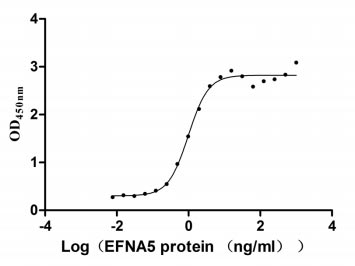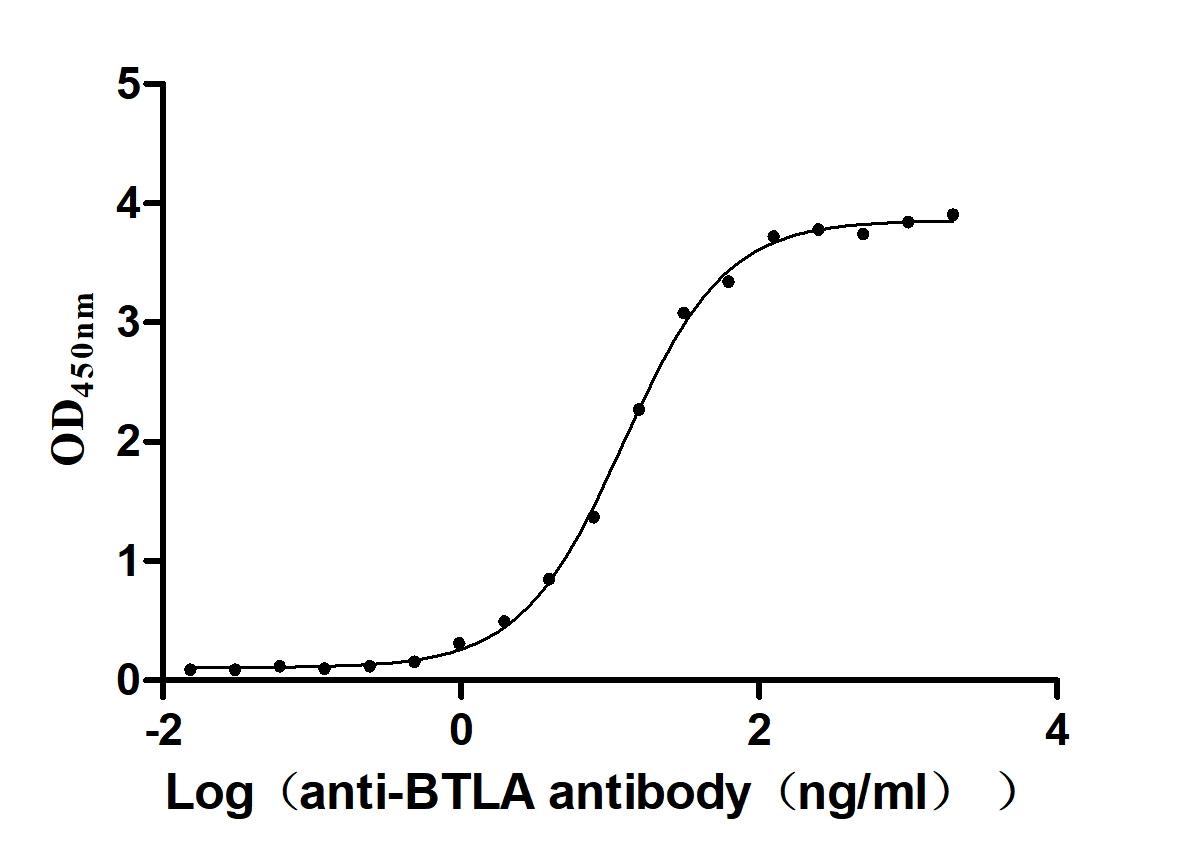Recombinant Mouse C-C chemokine receptor-like 2 (Ccrl2)
-
货号:CSB-CF004852MO
-
规格:
-
来源:in vitro E.coli expression system
-
其他:
产品详情
-
基因名:
-
Uniprot No.:
-
别名:Ccrl2; Ccr11; Lccr; C-C chemokine receptor-like 2; Chemokine receptor CCR11; G-protein coupled beta chemokine receptor; Lipopolysaccharide-inducible C-C chemokine receptor; L-CCR
-
种属:Mus musculus (Mouse)
-
蛋白长度:Full length protein
-
表达区域:1-360
-
氨基酸序列MDNYTVAPDDEYDVLILDDYLDNSGPDQVPAPEFLSPQQVLQFCCAVFAVGLLDNVLAVF ILVKYKGLKNLGNIYFLNLALSNLCFLLPLPFWAHTAAHGESPGNGTCKVLVGLHSSGLY SEVFSNILLLVQGYRVFSQGRLASIFTTVSCGIVACILAWAMATALSLPESVFYEPRMER QKHKCAFGKPHFLPIEAPLWKYVLTSKMIILVLAFPLLVFIICCRQLRRRQSFRERQYDL HKPALVITGVFLLMWAPYNTVLFLSAFQEHLSLQDEKSSYHLDASVQVTQLVATTHCCVN PLLYLLLDRKAFMRYLRSLFPRCNDIPYQSSGGYQQAPPREGHGRPIELYSNLHQRQDII
Note: The complete sequence including tag sequence, target protein sequence and linker sequence could be provided upon request. -
蛋白标签:N-terminal 10xHis-tagged
-
产品提供形式:Liquid or Lyophilized powder
Note: We will preferentially ship the format that we have in stock, however, if you have any special requirement for the format, please remark your requirement when placing the order, we will prepare according to your demand. -
缓冲液:Lyophilized from Tris/PBS-based buffer, 6% Trehalose, pH 8.0
-
储存条件:Store at -20°C/-80°C upon receipt, aliquoting is necessary for mutiple use. Avoid repeated freeze-thaw cycles.
-
保质期:The shelf life is related to many factors, storage state, buffer ingredients, storage temperature and the stability of the protein itself.
Generally, the shelf life of liquid form is 6 months at -20°C/-80°C. The shelf life of lyophilized form is 12 months at -20°C/-80°C. -
货期:Basically, we can dispatch the products out in 1-3 working days after receiving your orders. Delivery time may differ from different purchasing way or location, please kindly consult your local distributors for specific delivery time.Note: All of our proteins are default shipped with normal blue ice packs, if you request to ship with dry ice, please communicate with us in advance and extra fees will be charged.
-
注意事项:Repeated freezing and thawing is not recommended. Store working aliquots at 4°C for up to one week.
-
Datasheet & COA:Please contact us to get it.
相关产品
靶点详情
-
功能:Receptor for CCL19 and chemerin/RARRES2. Does not appear to be a signaling receptor, but may have a role in modulating chemokine-triggered immune responses by capturing and internalizing CCL19 or by presenting RARRES2 ligand to CMKLR1, a functional signaling receptor. Plays a critical role for the development of Th2 responses.
-
基因功能参考文献:
- Ccrl2 modulates chemerin levels in the epithelial lining fluid of the lungs but does not contribute to the development of O3-induced lung pathology. PMID: 29242308
- upregulation of CCRL2 observed under inflammatory conditions is functional to finely tune CXCR2-mediated neutrophil recruitment at sites of inflammation. PMID: 28743719
- chemokine (CC motif) receptor-like 2 should be considered to be a molecule involved in the regulation of the inflammatory response associated with multiple sclerosis. PMID: 26744451
- CCRL2 mRNA was not significantly changed in murine and human non-alcoholic steatohepatitis liver. CCRL2 was related to the mRNA levels of F4/80, transforming growth factor beta and alpha smooth muscle actin in murine non-alcoholic steatohepatitis. PMID: 28600126
- Proinflammatory stimuli upregulate atypical chemerin receptor CCRL2 and VCAM-1 on endothelial cells via NF-kappaB and JAK/STAT intracellular signaling pathways. PMID: 22696441
- Ccrl2(-/-) mice showed normal recruitment of circulating dendritic cells (DC) into the lung, but a defective trafficking of antigen-loaded lung DC to mediastinal lymph nodes. PMID: 20606167
- Expression of L-CCR mRNA is reported in murine astrocytes and microglia and is greatly enhanced under proinflammatory conditions; this receptor may play a role in neuroinflammatory processes. PMID: 12555200
- Prominent expression of L-CCR mRNA is detected in astrocytes and microglia at early time points throughout the brain and spinal cord in experimental autoimmune encephalomyelitis supporting the proposed relationship of L-CCR expression to CNS inflammation. PMID: 14999816
- Results identify chemerin as a natural nonsignaling protein ligand for both human and mouse CCRL2. PMID: 18794339
显示更多
收起更多
-
亚细胞定位:Cell membrane; Multi-pass membrane protein.
-
蛋白家族:G-protein coupled receptor 1 family
-
组织特异性:Expressed in macrophages, astrocytes, in glial cells. Constitutively expressed by mast cells. Detected in bronchial epithelium in OVA-induced airway inflammation. Up-regulated during dendritic cell (DC) maturation.
-
数据库链接:
KEGG: mmu:54199
STRING: 10090.ENSMUSP00000107519
UniGene: Mm.7336
Most popular with customers
-
Recombinant Human Ephrin-A5 (EFNA5) (Active)
Express system: Mammalian cell
Species: Homo sapiens (Human)
-
Recombinant Human Microtubule-associated protein tau (MAPT) (Active)
Express system: Mammalian cell
Species: Homo sapiens (Human)
-
Recombinant Mouse Cell adhesion molecule 1 (Cadm1), partial (Active)
Express system: Mammalian cell
Species: Mus musculus (Mouse)
-
Recombinant Macaca fascicularis CUB domain containing protein 1 (CDCP1), partial (Active)
Express system: Mammalian cell
Species: Macaca fascicularis (Crab-eating macaque) (Cynomolgus monkey)
-
Recombinant Human B- and T-lymphocyte attenuator(BTLA), partial (Active)
Express system: Mammalian cell
Species: Homo sapiens (Human)
-
Recombinant Human C-C chemokine receptor type 6(CCR6)-VLPs (Active)
Express system: Mammalian cell
Species: Homo sapiens (Human)
-
Recombinant Human Urokinase-type plasminogen activator(PLAU) (Active)
Express system: Mammalian cell
Species: Homo sapiens (Human)
-
Recombinant Human Tumor necrosis factor ligand superfamily member 15(TNFSF15) (Active)
Express system: Mammalian cell
Species: Homo sapiens (Human)



-AC1.jpg)





-AC1.jpg)










